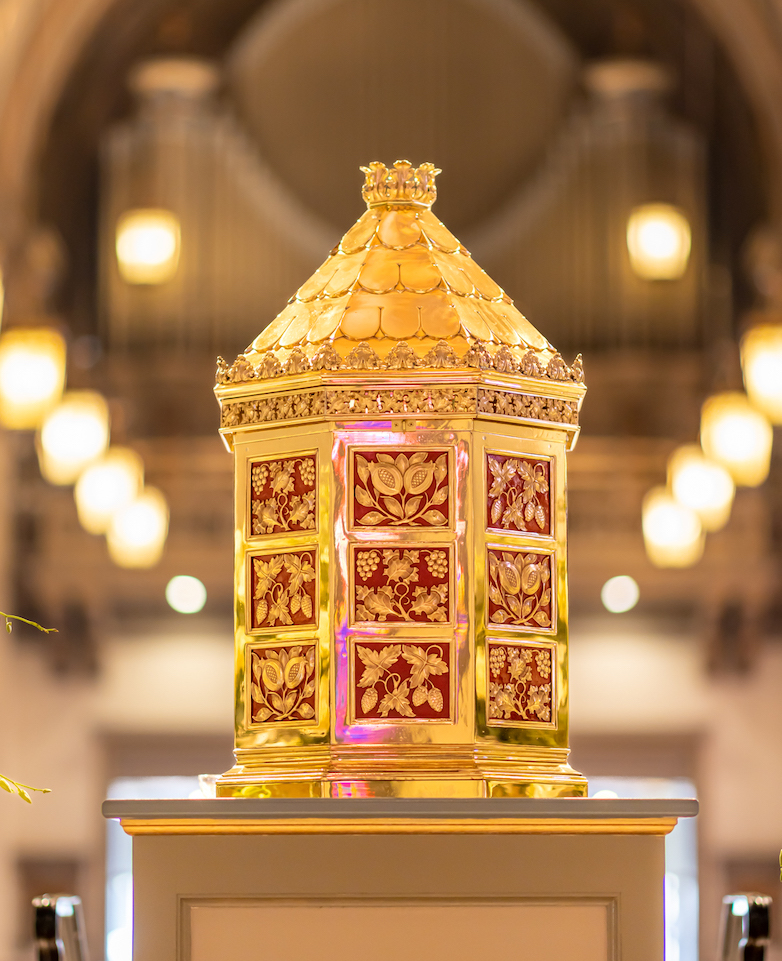While praying in our pew after Communion during a recent Sunday Mass, our 6-year-old son decided to administer a pop quiz to his willing little sister.
“What was the first tabernacle?” he asked. “I have no idea,” she replied. “Mary, of course! Her tummy held Jesus for the first time,” he answered.
“But what was the second tabernacle?” she shot back. My son then looked at me, tables turned on him from trying to stump his sister to now being stumped by her. “Do you know?” he asked me.
Of course, I could have gone a variety of directions with this. But as I raised my eyes, I was drawn immediately to St. Joseph in the crèche, as we were still in the Christmas season. “St. Joseph’s arms were,” I blurted out, without much thinking.
That got me thinking, then, of what the subsequent “tabernacles” might have been. The manger itself? Maybe the arms of the innkeeper’s wife? Maybe a shepherd? No matter who or what might have held Our Lord next, we know it was an unworthy place for the Lord of the universe.
But what of the tabernacles today? We have beautiful receptacles crafted of precious metals in churches and chapels. Our tabernacles contain the Eucharistic species remaining after Mass, especially reserved for the sick and dying and for both public and private worship, and adoration outside of Mass.
The glowing sanctuary lamp next to the tabernacle tells us Jesus is there. When we recognize his presence, we are drawn to show reverence to Christ’s sacramental presence in our midst. By gestures and prayers, we make clear our faith in his Real Presence and show him our love and devotion.
As my mind wandered about tabernacles, I thought of how each of us, too, in a sense becomes a tabernacle. We are members of Christ’s body by baptism. We are temples of the Holy Spirit.
When we receive Holy Communion, Christ’s body, blood, soul and divinity dwells within us just as the Word was made flesh and came to dwell among us in Mary’s womb at Nazareth so long ago. As the bread and wine lying on the altar are changed by the Holy Spirit into Christ’s Eucharistic flesh and blood, so, too, ought we be changed by receiving the sacrament.
But as the beauty and location of the tabernacle reveal what it contains, as the sanctuary lamp announces it is indeed the Lord, what heralds to the world Christ’s presence in us?
Christ in us is holiness. And as with any saint, we come to know Christ dwells in them by how they live, by the evidence of virtue in their lives. This means ensuring that we do our part to allow God’s grace to nourish and grow the gifts he’s already given us. When struggles and difficulties come, how do we respond? When life unfolds differently than planned, how do we react?
When God wants us to be his tabernacle, what do we do?
The short answer is, of course, is to live as Christ did. The Eucharist contains the grace we need to live Christ and give Christ. The Eucharist is our roadmap to virtue, the blueprint for holiness. The Eucharist is the key to opening up the tabernacle of our hearts and letting Christ live in the world.
While I’m not sure what – or more likely who – was the second tabernacle, I know it’s a calling for each of us. Will we stretch out our arms, open our hearts, give him room?
And what will be the effect? Will the world come to know Christ by our letting him make his dwelling anew in us? If we more faithfully accept our calling to be tabernacles in the world, might the world come to believe?
Michael R. Heinlein is author of “Glorifying Christ: The Life of Cardinal Francis E. George, O.M.I.” and a promised member of the Association of Pauline Cooperators.

